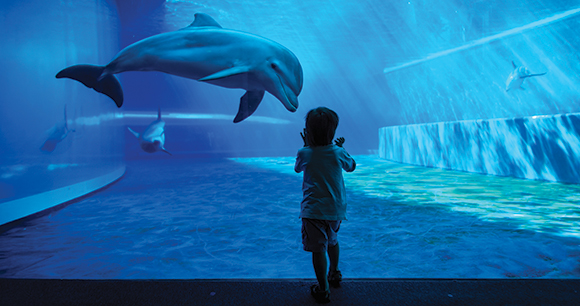Since 2013, with the release of the documentary Blackfish, the campaign to end the captive display of cetaceans has made strong progress. Locations where free-ranging cetaceans were still captured for sale to dolphinariums have shuttered operations; legislation restricting or phasing out captive display of cetaceans has passed in several countries; and (outside of China) the number of captive cetaceans held for display has declined.

Not surprisingly, dolphinariums are doing what they can to turn the tide. They and their adherents have published scientific papers purporting to show that captive display benefits cetaceans, while sanctuaries would be dangerous for them. Since 2012, they have tried to import new breeding stock (other than bottlenose dolphins, most species are held in such small numbers that inbreeding is a risk), but have failed so far, due to the efforts of AWI and other organizations. Dolphinariums are also heavily promoting their work with stranding networks. AWI accepts that there will always be rescued cetaceans who are non-releasable, which is one reason we support establishing sanctuaries. For now, such animals are held by dolphinariums.
Most recently in the United States, dolphinariums have begun an effort to reclassify “public display” as “research” and/or conservation “enhancement” under the Marine Mammal Protection Act (MMPA). Under this landmark law, these are the three allowed purposes for holding marine mammals in captivity. When the marine mammal is listed under the Endangered Species Act (ESA), however, only research and/or enhancement are allowed. Enhancement, by regulatory definition, means breeding and returning the resulting progeny to the wild to augment declining populations, which to date has never been done by US cetacean facilities.
Waikiki Aquarium
The Waikiki Aquarium in Honolulu focuses on displaying local species. They have held various endangered Hawaiian monk seals in the past. They now hold one male, Hō‘ailona (aka KP2), who is presently at Long Marine Laboratory in Santa Cruz, California, where the facility is conducting research under an expiring MMPA permit. The Waikiki Aquarium is applying for a new permit, this time for enhancement.
However, the aquarium does not intend to breed KP2, let alone return any of his offspring to the wild. (It explicitly states it will not conduct research with him either.) Therefore, this permit would in fact be for public display only—which, again, is not allowed for endangered species under the MMPA.
AWI sees the current application as an effort to blur the lines between the three types of MMPA permits, so that displaying animals becomes de facto enhancement. The permit application devotes an entire section to describing the husbandry of maintaining KP2 in captivity, claiming it is “enhancement,” in the sense of enhancing his individual welfare. But “enhancement” legally means enhancing the conservation of the species. A captive marine mammal’s individual welfare is addressed under the Animal Welfare Act, not the MMPA.
Our public comments urge the government to insist that the Waikiki Aquarium apply for a research permit and submit a research proposal for KP2—it should not even consider this permit request as it stands.
SeaWorld San Antonio
The Cook Inlet beluga whale population in Alaska is listed as endangered under the ESA. In 2017, Tyonek, a month-old male, was rescued there and deemed non-releasable, due to his age and inability to learn survival skills. He was sent to SeaWorld San Antonio soon after for permanent holding, with the understanding that he would be the subject of research, primarily to aid in the recovery of the Cook Inlet population.
Research permits must be renewed periodically. SeaWorld has duly applied to renew Tyonek’s permit, but its application has a number of weaknesses. AWI will urge the government to require revisions to the research proposal and insert certain provisions in the permit. For any behavioral research, the proposal should detail the hypotheses to be tested, with replicable methodology and an explanation as to how the research is relevant to Cook Inlet beluga conservation. (The current proposal is vague and does not specify how one animal who developed his present behavior while being raised with unrelated animals at SeaWorld can produce research results of relevance to his natal population.) Any research permit issued must specify that (1) breeding Tyonek is prohibited and (2) any proposal for moving Tyonek to another facility must be made in consultation with the relevant government agency, which has the final decision-making authority for any move.
Clearwater Marine Aquarium
Clearwater Marine Aquarium is a Florida rescue facility that for years has been responding to injured and stranded marine wildlife, rehabilitating and releasing them back to the wild, and, when necessary, providing permanent homes for non-releasable individuals. It currently holds two rough-toothed dolphins and three common bottlenose dolphins, all of whom were rescued very young or with injuries or conditions that rendered them non-releasable.
To provide better conditions for the permanent residents and more room for rescues, Clearwater Marine Aquarium undertook a substantial expansion (completed in 2021), building a new dolphin facility that features more space than the original facility. However, rather than reserve the added space for future rescues, the aquarium seeks to fill it with five captive-born male dolphins from Greece. It has applied for an import permit for these animals, claiming they need a home after the Greek facility decided to close its dolphin exhibit.
Among other reasons, AWI opposes this import because (1) these captive-born dolphins should remain in the European Union rather than become part of the unsustainable international trade in live cetaceans, and (2) the Greek facility operated for a decade in violation of Greek law prohibiting animal performances in zoos and aquariums and only chose to close its dolphin exhibit when the Greek government finally enforced this law. Under the MMPA, the source of any marine mammal import must be in compliance with domestic law. Clearly, the Greek facility did not meet that standard for many years. There is no mention of this history in the application.
AWI will continue to counter any efforts by dolphinariums to rebrand themselves as saviors rather than exploiters of marine mammals.